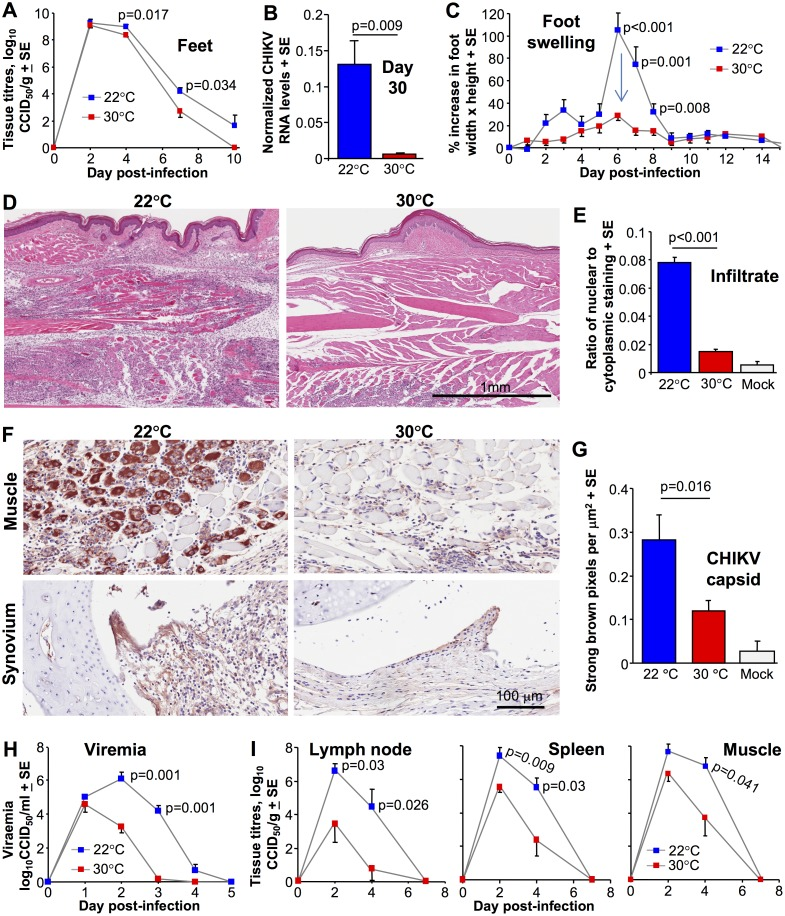Lower temperatures reduce type I interferon activity and promote alphaviral arthritis.
Chikungunya virus (CHIKV) belongs to a group of mosquito-borne alphaviruses associated with acute and chronic arthropathy, with peripheral and limb joints most commonly affected. Using a mouse model of CHIKV infection and arthritic disease, we show that CHIKV replication and the ensuing foot arthropathy were dramatically reduced when mice were housed at 30°C, rather than the conventional 22°C. The effect was not associated with a detectable fever, but was dependent on type I interferon responses. Bioinformatics analyses of RNA-Seq data after injection of poly(I:C)/jetPEI suggested the unfolded protein response and certain type I interferon responses are promoted when feet are slightly warmer. The ambient temperature thus appears able profoundly to effect anti-viral activity in the periphery, with clear consequences for alphaviral replication and the ensuing arthropathy. These observations may provide an explanation for why alphaviral arthropathies are largely restricted to joints of the limbs and the extremities.
Authors
Natalie A Prow; Bing Tang; Joy Gardner; Thuy T Le; Adam Taylor; Yee S Poo; Eri Nakayama; Thiago D C Hirata; Helder I Nakaya; Andrii Slonchak; Pamela Mukhopadhyay; Suresh Mahalingam; Wayne A Schroder; William Klimstra; Andreas Suhrbier
External link
Publication Year
Publication Journal
Associeted Project
Microbiology or Immunology
Lista de serviços
-
Gene regulatory and signaling networks exhibit distinct topological distributions of motifs.Gene regulatory and signaling networks exhibit distinct topological distributions of motifs.
-
Gene signatures of autopsy lungs from obese patients with COVID-19.Gene signatures of autopsy lungs from obese patients with COVID-19.
-
Network Medicine: Methods and ApplicationsNetwork Medicine: Methods and Applications
-
ACE2 Expression Is Increased in the Lungs of Patients With Comorbidities Associated With Severe COVID-19.ACE2 Expression Is Increased in the Lungs of Patients With Comorbidities Associated With Severe COVID-19.
-
Drug repositioning for psychiatric and neurological disorders through a network medicine approach.Drug repositioning for psychiatric and neurological disorders through a network medicine approach.
-
Linking proteomic alterations in schizophrenia hippocampus to NMDAr hypofunction in human neurons and oligodendrocytes.Linking proteomic alterations in schizophrenia hippocampus to NMDAr hypofunction in human neurons and oligodendrocytes.
-
In-depth analysis of laboratory parameters reveals the interplay between sex, age, and systemic inflammation in individuals with COVID-19.In-depth analysis of laboratory parameters reveals the interplay between sex, age, and systemic inflammation in individuals with COVID-19.
-
The evolution of knowledge on genes associated with human diseasesThe evolution of knowledge on genes associated with human diseases
-
Network vaccinology.Network vaccinology.
-
Pyruvate kinase M2 mediates IL-17 signaling in keratinocytes driving psoriatic skin inflammationPyruvate kinase M2 mediates IL-17 signaling in keratinocytes driving psoriatic skin inflammation
-
Transcriptome analysis of six tissues obtained post-mortem from sepsis patientsTranscriptome analysis of six tissues obtained post-mortem from sepsis patients
-
Gene Signatures of Symptomatic and Asymptomatic Clinical-Immunological Profiles of Human Infection by Leishmania (L.) chagasi in Amazonian BrazilGene Signatures of Symptomatic and Asymptomatic Clinical-Immunological Profiles of Human Infection by Leishmania (L.) chagasi in Amazonian Brazil
-
In vitro morphological profiling of T cells predicts clinical response to natalizumab therapy in patients with multiple sclerosis.In vitro morphological profiling of T cells predicts clinical response to natalizumab therapy in patients with multiple sclerosis.
-
Integrative immunology identified interferome signatures in uveitis and systemic disease-associated uveitis.Integrative immunology identified interferome signatures in uveitis and systemic disease-associated uveitis.
-
Gene regulatory networks analysis for the discovery of prognostic genes in gliomas.Gene regulatory networks analysis for the discovery of prognostic genes in gliomas.
-
Revealing shared molecular drivers of brain metastases from distinct primary tumors.Revealing shared molecular drivers of brain metastases from distinct primary tumors.

